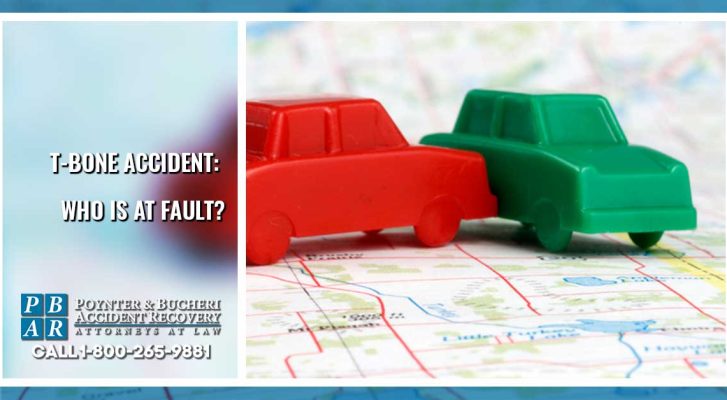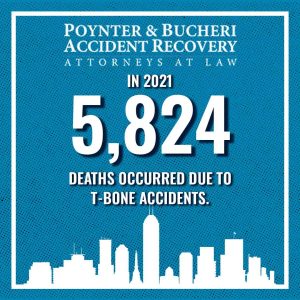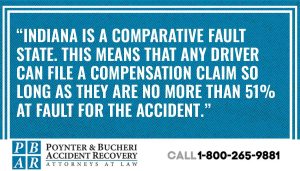
T-Bone Accident: Who Is at Fault?

If you’ve been injured in a T-bone accident, you may be entitled to compensation that can help pay for your injuries and other potential damages. However, as Indiana is an at-fault state, you must be able to prove that another party was at-fault to file a claim against them and win your case.
Unfortunately, T-bone accident cases can be more complex than other collisions because it can be more challenging to tell which driver is at fault. That said, proving fault is not impossible.
If you were injured in a T-bone accident, a lawyer can help. You will need to obtain evidence to prove what happened and build a strong case against the other driver — and a lawyer can help you do this.
At Poynter & Bucheri, our Indianapolis T-bone accident lawyers have helped countless victims like yourself win their cases. If you need help proving fault and recovering the compensation you deserve, don’t hesitate to reach out to our legal team for assistance.
What is a T-Bone Accident?
A T-bone accident is another way of saying a side impact collision or a broadside accident. The reason for the name is that this type of collision occurs when one car collides head-on with the side of another car, which creates the shape of a “T.”
T-bone accidents can happen in many ways, but most often, they occur in the following situations:
- When a driver runs a red light and crashes into another driver proceeding through an intersection
- When a driver runs a stop sign and runs into another car
- When a driver turns left in front of oncoming traffic
- When a driver fails to yield the right of way at intersections or when pulling out of driveways or parking lots
Other factors can contribute to the likelihood of a T-bone accident, such as speeding, distracted driving, driving under the influence, and driving while fatigued.

Are T-Bone Accidents Deadly?
T-bone accidents are considered one of the second most deadly kinds of collisions. Head-on or frontal impact crashes hold the number one spot. In 2021, 5,824 deaths occurred due to T-bone accidents.
Of course, not all T-bone accidents are deadly. But when these accidents happen at high speeds and when passengers are seated on the same side as the point of impact, the injuries are more likely to be severe and life-threatening.
Some common T-bone accident injuries include:
- Traumatic brain injuries
- Spinal cord injuries
- Neck injuries
- Crush injuries
- Internal organ damage
- Severe lacerations and fractures
Who Is at Fault in a T-Bone Car Accident?

Various parties could be at fault in a T-bone collision. It is not necessarily the driver that ran into the other car that is to blame.
For example, if a driver doesn’t stop at a stop sign and they are hit by another car proceeding through the intersection that didn’t have a stop sign, then the driver that ran their stop sign is at fault, not the driver that hit them.
Another example would be a driver turning left when they have a turn signal. If they turn left when given the signal to do so, but an oncoming driver runs their red light and hits them, then the driver that hit the turning vehicle would be at fault.
When these accidents occur, various factors must be taken into consideration to determine who was ultimately the one at fault. It’s also important to note that it is possible for both drivers involved to share in liability for what happened.
For example, if a driver ran a stop sign, but the driver they hit was speeding, then both drivers could carry some blame.
Indiana is a comparative fault state. This means that any driver can file a compensation claim so long as they are no more than 51% at fault for the accident. When they file their claim, the amount they are awarded will be reduced by their percentage of fault.
So continuing with the example above — if one driver runs a stop sign and the other is speeding, they could both be at fault. But the driver that ran the stop sign will likely carry a higher percentage of the blame. For instance, the one that ran the stop sign could be determined to be 70% at fault, and the one that was speeding could be 30% at fault. In this case, only the driver that was speeding could file a claim, but their compensation would be reduced by 30%.
How to Prove Fault in a T-Bone Accident
How would fault be determined in a T-bone accident?
When these kinds of accidents happen, and there is a dispute over who is at fault, evidence will be used to prove which driver is ultimately the one to blame or the one that carries the higher percentage of responsibility. Such evidence can include:
- Police reports
- Surveillance footage from security cameras nearby
- Photos and videos captured on cell phones
- Eye witness statements
- Accident reconstruction diagrams
The more evidence you can gather in these cases, the better. And your best chance of getting all of the evidence you need is working with an attorney. Gathering evidence on your own will not be easy, and even once you have the evidence, you may still need to build a strong argument to show how the evidence proves that you were not at fault — and an attorney can help with this.
A lawyer can also ensure you are fairly compensated after you win the case. Insurance companies do not always award fair settlements, but an attorney can handle negotiations with them to avoid this. A lawyer can also represent you in court if your case goes to trial.
Consult With an Indianapolis T-Bone Accident Lawyer
If you are injured in a T-bone accident in Indiana, our experienced team of personal injury attorneys can help. At Poynter & Bucheri, we understand how challenging T-bone accident cases can be and know what it takes to ensure the right party is held liable.
Don’t hesitate — an experienced Indiana car accident lawyer can assist you right away. Call 1-800-265-9881 for a free case review.
